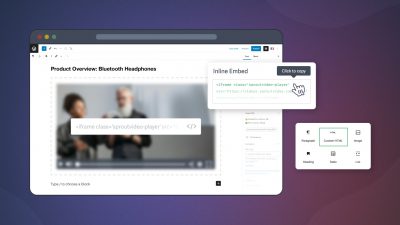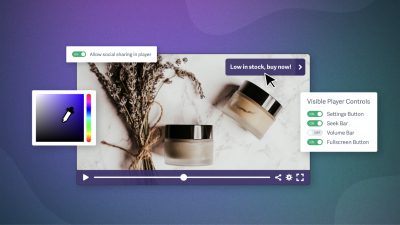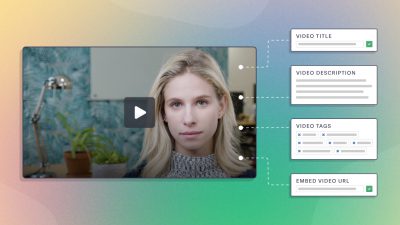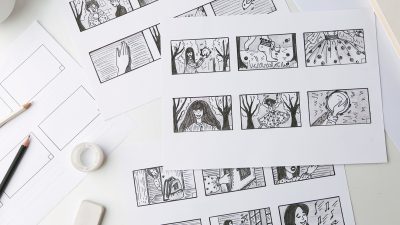Butterflies, jitters, dry mouth, vertigo, even mild nausea – all symptoms of the fact that you’re just plain uncomfortable in front of the camera. From our experience, that’s very common. In fact, it’s normal.
But, it doesn’t have to be that way. In this post, we cover thirteen of the best tips for overcoming your fear of the lens to help you face the camera confidently.
1. Practice Early and Often
If you feel confident you know what you’re doing, you won’t fret nearly as much. By memorizing what you have to say or do in each take, you also eliminate the risk you’ll miss something if you get nervous.
Sometimes, this isn’t even about remembering your lines or cues. It can also mean the actual process of setting up the camera and hitting record. Try practicing this process, even if you’re just goofing around. It will start to feel much less intimidating over time.
2. Prepare For Mistakes
Even if you’ve rehearsed a million times, you still might freeze once the camera starts rolling. Plan ahead, and come up with ways to unblock your mind just in case.
For instance, you could come up with mnemonic devices to help you remember what comes next. Or, write notes or draw on a cue card that can be displayed behind the camera to jog your memory if you get stuck.
3. Film Multiple Takes
The simplest video can benefit from multiple takes. Sometimes, the words just come out slightly clearer the second time, the lighting might be a little better, or there might be a silly goof you need to cover up with a clever edit.
Filming multiple takes means there’s less pressure on any single shot to be absolutely perfect. If you build this approach into your plan for filming, it will help you relax knowing you get to try it again in a few minutes.
4. Deep Breaths
A specific breathing technique can help focus your mind, and destress your body. Importantly, it can also help your voice come down several octaves if you’ve already tensed up and are a little squeaky.
Called belly breathing, you start by inhaling deeply through your nose, letting your stomach expand naturally as your lungs fill up with air. Slowly release the air from your lungs, mirroring the time it took you to fill them up. Sometimes it helps to count to 5 or 10 as you inhale and exhale. Repeat until you feel calm.
Note: it’s important to breathe more slowly than normal when employing this technique. Since you’re taking in more oxygen than normal, your regular pace of breathing could make you feel a little light-headed, or yawn. Go slow, and you’ll be fine.
Belly breathing helps to balance the levels of oxygen and carbon dioxide in your blood. This works to eliminate sweaty palms, tingling sensations in your extremities, and other symptoms of stress. Try it for a few breaths to see what a difference it can make.
It also sends a signal to your brain that you should be relaxed. This type of deep breathing is associated with natural states of relaxation, and tells your brain it’s ok to calm down.
5. Study Professionals
The next time you flip on the TV, make a point of noting how people on the screen perform. Are they seated, or standing? What’s their posture like? Where do they rest their eyes when speaking? How quickly do they speak? What types of gestures do they use?
All of this information can directly inform your own performance in front of the camera. It might even help to create your own on-screen persona, or to emulate someone in particular.
6. Try Public Speaking Classes
Projecting confidence is the name of the game, and is key to public speaking. Getting used to being in front of a crowd can help enormously with your appearances on camera.
Often, local high schools or universities have community ed classes you can take for free. Even a single seminar on public speaking could provide some tricks you can use on camera.
7. Make It A Habit
If you only make video once in a blue moon, you’ll find it much harder to overcome your fears than if you do it all the time. We often fear the unfamiliar.
It doesn’t necessarily have to be a polished or professional production. There are many ways you can work video into your day-to-day life.
Try making fun videos on Snapchat, Facebook, or Instagram to share with your friends. Broadcast something live. Insist on a video call instead of a regular phone call. Convert your presentation into a video.
The more you work with video, the less intimidating it will feel over time.
8. Try a Video Challenge
To help you get over your hangups, commit to making one video every day, week, or month. Pick a theme, pencil it into your schedule, and block the time to tackle it in advance.
Over the course of the challenge, you’re likely to make mistakes, and that’s perfectly fine. It’s kind of the whole point. Learning from mistakes will help you grow your confidence that you’ll get it right the next time.
9. Wear A Favorite Outfit
If you look good, you’ll feel good, as the saying goes. It doesn’t matter if your favorite outfit is a little quirky. After all, TV personalities have worn interesting outfits for years!
There is a clear line between quirky, and inappropriate however. Make sure your clothes are clean, and wrinkle free. Avoid stripes, small patterns, or shiny accessories, as they can cause visual issues on camera. Jewelry that makes a lot of noise is also a no-no since it could interfere with the audio.
10. Volunteer For Other Projects
Got any friends making a video? A local video studio that needs talent? What about a nearby high school putting on a play they’d like to film?
Volunteer your time to help others with video work. You’ll learn more each time you participate in a shoot. Even if you’re not on camera, you can still pick up tips and tricks from being a part of a production.
11. Go Behind the Camera
Similarly, coaching someone else on camera might make you feel more comfortable in front of it. Seeing it from both sides can help you gain perspective on what works, and what doesn’t.
12. Focus Your Gaze
One of the biggest complaints we hear from people is that they just don’t know where to look when they’re on camera. The answer is that it really depends on the type of video you’re making:
- If it’s live action, actors should interact with the other characters, and avoid looking into the lens at all costs (unless it’s scripted).
- If it’s an interview, have the subject face the person interviewing them. You can position the camera to the side of the interviewer, or use multiple cameras to get both sides of the conversation. In either case, the subject should look at the interviewer and not the camera.
- If it’s a talking head video, the subject should look directly into the camera. If this feels too intense, try looking slightly above the camera, or at the person operating the camera.
Keeping a steady gaze will allow you to project confidence on camera, whether you’re feeling it or not!
13. Use Biofeedback
Belly breathing is just one way to tell your body it should relax. You can also use correct posture and gentle stretching to reduce tension.
For example, if you catch yourself crossing your arms and legs tightly, wringing your hands, or fidgeting, you’re only reinforcing your nervous state.
Sitting up straight, folding your hands in your lap, and crossing your ankles (if seated) are ways to not only project confidence, but to also calm the mind.
If you’re standing, you can clasp your hands loosely in front of your body with your elbows bent, and keep your feet a comfortable distance apart. Swaying or moving excessively might mean you fall out of frame, so try to keep your torso still. You can tilt your head, shift your weight from one side to the other, or move your arms to express yourself instead.
In between takes, roll your shoulders, walk around, and stretch your arms gently to make sure you don’t stiffen up.
Do you have any tips for facing your fears, and being on camera? Let us know on Instagram, Facebook, Twitter, or LinkedIn!








